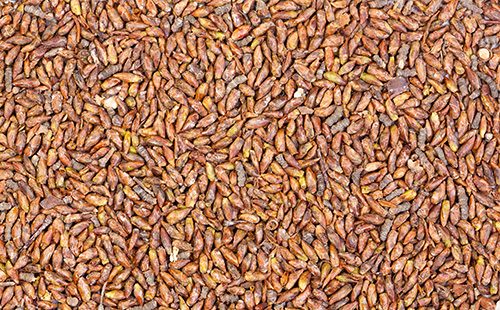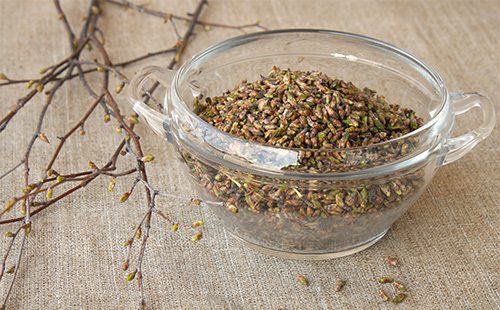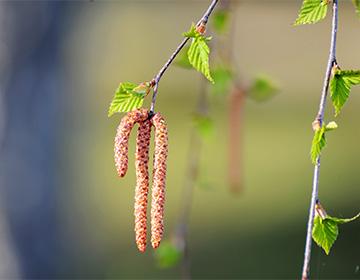The content of the article
Birch buds are called ovary leaves on tree branches (shrubs) that appear in mid-winter. In January they are small, dense, scaly. As the onset of heat swells, becomes larger. At the end of March, the flakes open, and tender leaves covered with a resinous substance hatch from them.
Characteristics of plant materials
At that moment, when the birch buds opened, they lose their pharmacological value. But too small in the cold winter months to collect is a mistake, since the concentration of nutrients in them is still minimal. The optimal harvesting time is considered the end of winter - the beginning of spring, depending on the period of heat in the region.
Collection and Harvesting
Harvested vegetable raw materials in strictly designated areas. In leskhoz, such territories or individual trees are usually indicated. They are intended for deforestation due to age or the need for forest renewal. Harvesting from young trees is not carried out. Refer to the following collection guidelines.
- Do not collect in the city. Firstly, the procurement of plant materials is prohibited. And secondly, it can not be considered environmentally friendly. Wood, like a sponge, absorbs toxins, there are especially many of them if the trees grow along the road. They are concentrated precisely in the kidneys, since the tree sends juices here in early spring.
- Plan collection until the kidneys are whole. In warm regions, harvesting is carried out in late January, in cold regions in mid-April. It is believed that winter raw materials are less valuable than spring, but this only applies to areas where spring comes late. It is important to collect before the first leaves appear.
- Cut whole branches. The buds of the leaves look like cones, the same scaly and smell of resin. Resinous substances cover them whole, from which the surface is sticky. At the time of collection, working with such raw materials is inconvenient, it sticks to hands, gloves. Therefore, they harvest it simply on branches, cutting them off with pruners, clippers.
- Air dry. Branches are tied in bunches and suspended under awnings or in attics. Drying temperature should be no more than 30aboutC. According to some herbalists, the best raw material is that which was dried in the cold. After three to four weeks, you can separate the medicinal mass from the branches by threshing them or cleaning off the mittens.
The threshed mass is poured into sieves through which weed impurities are sown. Store in linen bags, in dry rooms for no more than a year.
Composition
Medicinal raw materials are kidneys of an elongated conical shape, with a pointed tip.The scales are located like tiles, tightly pressed, their surface is smooth. The length is not more than 7 mm and not less than 3 mm. Diameter - up to 3 mm. During drying, the surface color darkens: the finished raw material acquires a saturated brown color. It has a pleasant resinous smell and astringent taste. It is given by tannins and resins, in large quantities contained in the mass. In addition, the healing properties of birch buds are determined by organic acids, as well as:
- alkaloids - up to 0.1%;
- flavonoids - kempferol, apigenin, etc .;
- higher fatty acids - up to 44%;
- essential oil - up to 8%.
pharmachologic effect
The rich composition of raw materials determines its complex effect on the body. Herbal remedy has the following effects:
- diuretic;
- choleretic;
- disinfectant, antimicrobial;
- anti-inflammatory;
- sweatshops.
The antibacterial effect is pronounced when treating birch buds with infectious and inflammatory diseases of the urinary system in men and women. Plant materials are included in complex preparations for the treatment of prostatitis, chronic cystitis, cholecystitis. In addition, the use of herbal remedies is justified in the following cases.
- Cardiovascular disease accompanied by edema. Dosage forms of phytochemicals well remove excess water from the body, which accumulates as a result of insufficient cardiac activity. Reduce the burden on the heart and kidneys.
- Gastrointestinal diseases. The bioactive complex stimulates the production of bile, without exerting an antispasmodic effect. Increases the productivity of the liver, gall bladder with gallstone disease, biliary dyskinesia. Recommended for fatty hepatosis, inflammation of the liver, stomach ulcer and duodenal ulcer.
- ENT diseases of the organs and respiratory system. Preparations with pronounced antiseptic properties are effective in the treatment of infectious, inflammatory processes of the upper respiratory tract. With angina, laryngitis, sinusitis, local treatment of the mucous membranes is shown, which allows to reduce the contamination of their pathogenic bacteria. When taken orally, they help cough, as they have a mild expectorant effect.
- Inflammation, skin damage. Aqueous dosage forms should be used to heal minor tissue damage: cuts, burns, pressure sores. The substances that make up the essential oil stimulate regeneration and accelerate healing. In folk medicine, compresses and rubbing are used to treat arthritis, arthrosis, myositis, poorly healing ulcers. A good effect is demonstrated by herbal medicine for non-infectious skin diseases: psoriasiseczema.
Contraindications
Preparations based on birch buds have a mild effect, but their use is limited in a number of conditions. Contraindications:
- pregnancy;
- children under 12 years old;
- acute inflammatory processes in the kidneys;
- renal failure.
It is important to consider that the composition of the herbal remedy contains resinous substances that are irritating to the kidney tissue. Therefore, taking the drug is limited for diseases of an inflammatory, infectious nature (nephritis, pyelonephritis, glomerulonephritis). Birch leaves that have no resins in their composition are much milder; therefore, their use in acute kidney diseases is safer.

Prescription Drugs
For the preparation of medicines, dried raw materials are used.It is stored for a long time, therefore, with inflammatory diseases, disorders of the digestive tract, skin lesions, a fresh composition is prepared.
Decoction
Features. It has diuretic properties, eliminates the "cardiac" swelling of the body and limbs. It stimulates the production of bile, improves well-being and digestion in diseases of the liver, gall bladder. Recommended as an antiseptic and expectorant for infectious diseases of the upper respiratory tract, accompanied by cough.
How to make and use
- Pour a tablespoon of raw material into an enameled container.
- Pour boiling water with a volume of 500 ml.
- Rinse under the lid in a water bath for 30 minutes.
- Leave to infuse for 40 minutes.
- Wring out the mass.
- Strain.
- Take three tablespoons three times a day 20 minutes before meals.
Alcohol tincture
Features. Universal remedy for indoor and outdoor use. In the first case, it exhibits choleretic, anti-inflammatory and diuretic actions. Compresses stimulate wound healing, tissue regeneration. With myositis, arthritis, edema, eczema, baldness rubbed into the affected areas to eliminate pain, inflammation, skin healing.
How to make and use
- Pour 100 g of dried raw materials into a jar.
- Pour alcohol with a strength of 90about 500 ml.
- Leave to brew for 21 days.
- Wring out the mass.
- Strain.
- Take orally from one teaspoon to one tablespoon three times a day before meals. (The dosage is selected individually, according to the weight of the patient. The maximum is prescribed for body weight over 80 kg).
- For external use, rub the product into the skin, affected joints, clean ulcers.
Vodka tincture
Features. In the absence of strong alcohol, it is allowed to prepare an infusion of vodka. In folk medicine, it is recommended for the treatment of diseases of the stomach - ulcers, pains, disorders and indigestions. Used for dropsy (edema) due to impaired renal function, with diseases of the bladder, liver. Skin diseases, varicose veins and rheumatism are treated with local compresses and rubbing.
How to make and use
- Pour 50 g of raw material into a jar.
- Pour in 500 ml vodka.
- Leave it for ten days.
- Wring out the mass.
- Strain.
- Take a teaspoon inside three times a day 20 minutes before meals, dissolving the drug in a small amount of water.
- For external treatments, use in pure form.

Ointment
Features. Recommended for arthritis, rheumatism, muscle pain. The ointment has a pronounced warming, anti-inflammatory effect. An alternative recipe involves the use of unsalted, unpasteurized butter. This will not work in the store, only order in the village or farm where the cows are kept.
How to make and use
- Place a finger-thick layer of oil on the bottom of the clay pot.
- Fill the raw materials with a layer of a similar thickness.
- Put another layer of oil and again the kidneys.
- Alternate until the pot is full.
- Close the lid, cover the cracks with dough.
- Put in the oven for two hours, simmer over low heat.
- Squeeze the oil out of the hot mass.
- Add camphor powder in a volume of 8 g, mix.
- Keep the mass in the refrigerator, corking tightly.
- Rub into joints, tissues with rheumatic, muscle pains.
With a cold, birch buds can be brewed like tea (a teaspoon of raw materials per glass of water). Such a tool will support the immune system: without an antiviral effect, it inhibits the growth of pathogenic bacteria, making the disease easier to carry and does not cause complications.

